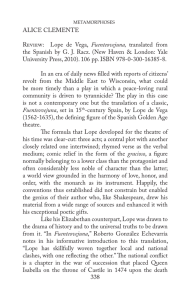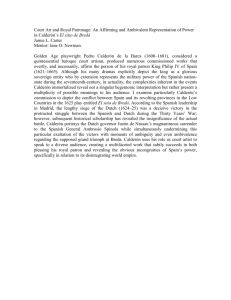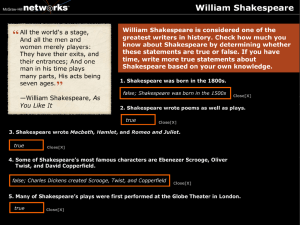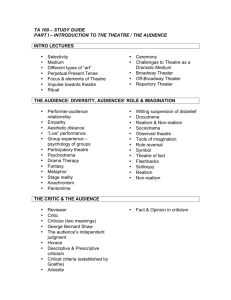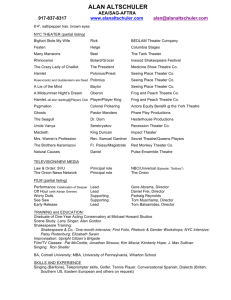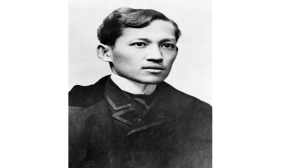The Spanish theater
advertisement
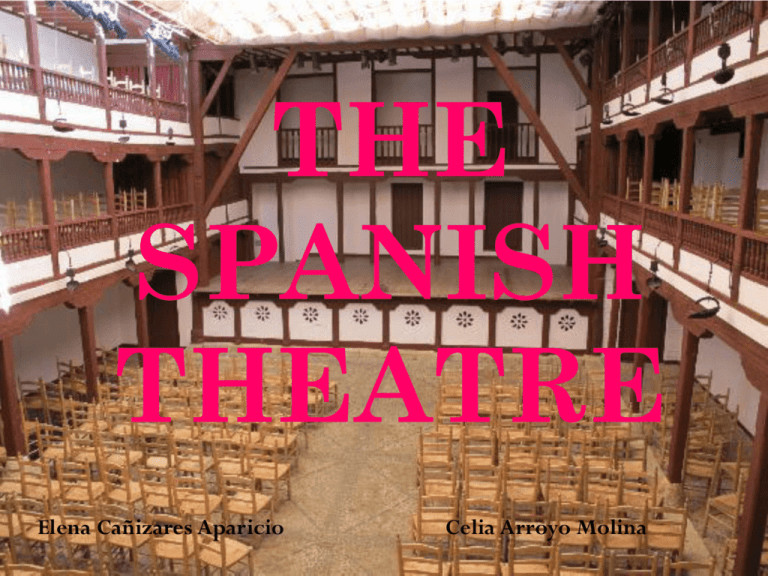
THE SPANISH THEATRE Elena Cañizares Aparicio Celia Arroyo Molina THE MOST FAMOUS AUTHORS IN THE SPANISH THEATRE Lope de Vega Federico García Lorca Calderón de la Barca Lope deVega was born on November the 25th of 1562, and died on August the 27th of 1635. He was one of the most important poets and dramatist of the century of Spanish gold and, because of the extension of his work, one of the major pieces’ producers of universal literature. INFANCY Félix Lope de Vega y Carpio, was a member of a humble family from Carriedo's valley, in the Cantabrian mountain. His parents were Félix de Vega, who was a embroiderer, and Francisca Fernandez Flórez. STUDYS He studied with the Jesuits of Madrid and in Alcalá’s university, but he didn´t managed to get a degree. THEATRICAL PRODUCTION It is very wide: approximately 400 bays remain, but he wrote many more. As it has been said, Lope is the great author of the popular theatre and, from this point of view, great part of his dramatic pieces are essentially destined to be represented in corrals. El villano en su rincón, published by the first time in 1617, though his composition is dated between 1611 and 1616 El caballero de Olmedo written surely in 1620 and it is based on a popular song. Fuenteovejuna was composed in three acts about 1613 and published in Madrid in 1618 inside the volume Dozena Parte of the Comedies of Lope deVega. El mejor alcalde, el rey waswritten between 1620 and 1623, according to Morley and Bruerton, and published in 1635 in the 21st parts of this author’s comedies. In his last years of life Lope de Vega fell in love with Marta de Nevares, in which can be considered to be "a" "sacrilege“ due to his priest condition. Marta was a very beautiful, green-eyed woman, as Lope declares in some poems dedicated to her, in which Lope refeers to Marta as "Amaryllis" or "Marcia Leonarda” . In this epoch of his life it cultivated specially the comical and philosophical poetry.. Calderón de la Barca was born on January 17, 1600, and died on May 25, 1681. He was a baroque Spanish writer of the Golden century, fundamentally known by his theatre INFANCY He started going to the college in 1605 in Valladolid, because there the Court was the, but as he stood out in the studies, his father decided to destine him to occupy a chaplaincy that was reserved by the grandmother to someone of the family that was a priest. HIS FIRST POETICAL CONTEST In 1621 it took part in the poetical contest which as celebrated because of San Isidro's beatification. Later he also took place in the contest of San Isidro’s canonization, in 1622, and gained the third prize. YOUTH He decided to leave the religious studies for the military career and took a slightly in a mess. He also had problems in the familiar area Amor, honor y poder is his first well-known comedy. Calderón published this work in the Alcázar of Madrid, in June, 29th 1623, when he was 23 years old El médico de su honra is a dramatic work, written about 1637. It is fitted in the baroque literature. It is about honor and jealousies, which are topics that Calderón wrote about very often. La dama duende is a comedy. It was compound and released in 1629. It was published for the first time in Primera parte de comedias de don Pedro Calderón de la Barca, in 1636 El alcalde de Zalamea is a dramatic work which was written in 1636. It is one of the most known and represented works in the Golden century Spanish’s literature. It is fitted in the baroque literature. When Calderón de la Barca died, he had written one hundred and ten comedies, and eighty eucharistic plays, praises, appetizers and other minor works. Calderón uses less number of figures and centres them concerning the protagonist, so that the work has a clear center of gravity, which reinforces the dramatic intensity. Federico García Lorca was born on June the 5th of 1898 and died on August the 19 th of 1936 Federico García Lorca was a poet and Spanish dramatist. STUDY In 1915 he began to study Philosophy and Letters, as well as Law in Granada’s University. H is a member of El Rinconcillo, where he met Manuel de Falla. Between 1916 and 1917 he made a series of trips around Spain with his university colleages, knowing Antonio Machado. In 1919 it moves to Madrid and establishes himself in the Students' Residence, coinciding with numerous writers and intellectuals. HIS WORK He wrote both poetry and theatre, but in the last years he overturned more in theatre. In his first poetry book he proves to be rather modernist, following the stela of Antonio Machado, Rubén Darío and Salvador Rueda. In the second stage links the Modernism with the Forefront, having a traditional base. CHRONOLOGY OF HIS WORKS •1919.- “El maleficio de la mariposa” •1923.- “El misterio de los reyes magos” •1923.- “Mariana Pineda” •1923.- “La niña que riega la albahaca y el príncipe preguntón” •1923.- “Lola la comedianta •1928.- “Teatro breve” •1929.- “Viaje a la luna” •1930.- “La zapatera prodigiosa” •1931.- “Tragedia de Don Cristóbal y la Señá Rosita” •1933.- “El público” •1934.- “Yerma” •1935.- “Doña Rosita la soltera o el lenguaje de las flores” •1936.- “La casa de Bernarda Alba” Luis Merlos María Adánez In “Aquí No Hay QuienViva”… Luis Merlo in a theater play… ¿Who is Luis Merlo? Luis Merlo is a Spanish actor very famous because she is “Mauri” in Aquí no hay quien viva and make many theater plays. Luis Merlo was born on June the 5th of 1966 in Madrid. He is the son of two great actors and grandson of another great actor. When their parents divorced. His grandfather teach to her grandos all of the theater things. Their three brothers are actors too. WORKS In ´”Aquí No Hay Quien Viva”… In “La Que Se Avecina”… Who is María Adánez? María Adanez is actress, executive producer and Spanish guionist very famous, because she is “Lucía” in Aquí no hay quien viva, and she’s “Rebeca” in La que se avecina and make many theater plays. María Adánez was born on March the 12th of1976 in Madrid. Since she is 16 years she start to make theater plays. She has participated in many theater plays, programmes and she has made monologues. WORKS The "International Classical Theatre Festival of Almagro" held in this historic town of "La Mancha" for 37 years, It has become over time a meet for theater lovers. ALL EDITIONS Palacio de Fúcares Plaza Mayor Hospital de San Juan Claustro del Museo del teatro Aruond the 40.000 persons go to meet, each edition, to go for many shows and activities that it is programmed at June, it changing this beautiful city in a big scene where the vers and the comics that they came on over the world amd they mingle with spectators and tourists, being when the magic of theater comes anywhere. In Almagro everythigs are possible … Iglesia de San Agustín Ermita de San Juan Corral de Comedias Teatro Municipal
